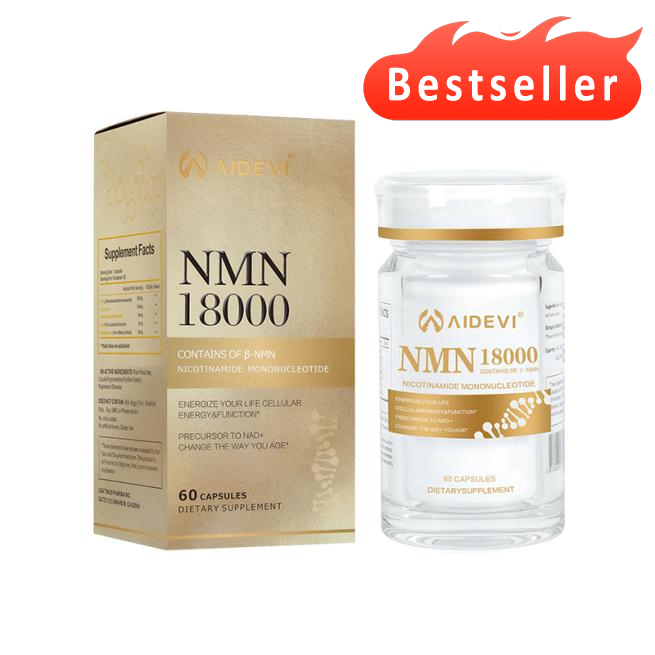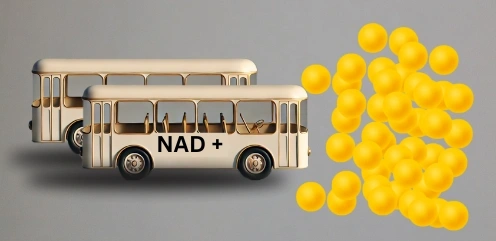How Does NAD+ Become NADH? A Simple Explanation of the NAD+ to NADH Cycle
![]()
Have you ever felt that midday slump or wondered why your energy levels seem to dip as the years go by? You're not alone—many of us experience this, and it often ties back to how our bodies convert food into usable energy. At the heart of this process are two key players: NAD+ and NADH. These molecules work tirelessly in your cells, much like a reliable team ensuring everything runs smoothly.
If you're curious about how NAD+ transforms into NADH and what it means for your well-being, we're here to break it down in a way that's easy to understand and relatable. We'll explore the science with empathy, knowing that maintaining energy and health is a common concern, especially as we age.
This guide explains the NAD+ to NADH conversion, why it’s vital for energy production, and how you can support healthy levels naturally.
Key Summary
- NAD+ and NADH are essential coenzymes that fuel your cells' energy production.
- NAD+ acts as an electron collector, turning into NADH by gaining electrons and hydrogen during metabolism.
- A healthy balance between NAD+ and NADH supports not just energy, but also metabolism, DNA repair, and overall cellular health.
- You can naturally support NAD+ levels through nutrient-rich foods, regular exercise, quality sleep, and considering precursors like NMN.
 |
A cellular NAD+ booster with ultra-pure NMN and resveratrol in research-proven dosages.*
|
 |
What is NAD+?
![NAD+ Bus]()
NAD+, or Nicotinamide Adenine Dinucleotide in its oxidized form, is like the unsung hero in your body's energy factory. It's a coenzyme that kicks off the process of turning the food you eat—carbs, fats, and proteins—into energy your cells can use. Imagine NAD+ as an empty backpack, ready to pick up important "cargo" (electrons) during metabolic reactions, setting the stage for energy creation.
Beyond energy, NAD+ plays a crucial role in repairing damaged DNA and activating proteins called sirtuins, which help regulate cell health and promote longevity. As we get older, it's common to see NAD+ levels naturally decrease, which might leave you feeling more tired or noticing a slower metabolism. But don't worry—keeping these levels supported can help maintain vitality and efficient cellular function.
What is NADH?
![NADH bus]()
NADH is essentially NAD+ after it's "loaded up." This reduced form comes about when NAD+ grabs electrons and a hydrogen ion during metabolic processes, transforming it into a powerhouse ready to donate that energy. Think of NADH as that same backpack, now full and heading straight to the mitochondria—the cell's power plants—to help produce ATP, the energy currency that keeps you going.
In addition to fueling energy, NADH helps combat oxidative stress by neutralizing harmful free radicals, which can damage cells over time. Some research points to its potential in supporting brain health and easing fatigue, offering a sense of relief for those dealing with low energy days. This cycle between NAD+ and NADH ensures your cells stay energized and resilient, adapting to your body's needs.
Quick Fact: NADH can donate electrons to create up to three ATP molecules per cycle, amplifying your body's energy output.
NAD+ vs NADH: Key Differences
Understanding NAD+ and NADH is like appreciating two sides of the same coin—they're interconnected but each has unique roles. NAD+ is the starting point, positively charged and eager to accept electrons to kickstart energy production. NADH, on the other hand, is neutral and energy-rich, donating those electrons to generate ATP.
Here's a simple comparison to highlight their differences:
| Feature |
NAD+ |
NADH |
| Full Name |
Nicotinamide Adenine Dinucleotide (oxidized) |
Nicotinamide Adenine Dinucleotide (reduced) |
| Charge |
Positively charged |
Neutral |
| Energy Level |
Low (accepts electrons) |
High (donates electrons) |
| Primary Role |
Electron acceptor, enzyme cofactor |
Electron donor for ATP production |
| Cellular Function |
DNA repair, metabolism regulation |
Energy transport, oxidative stress reduction |
| Effect of Aging |
Declines significantly |
More stable |
| Conversion Direction |
Becomes NADH during metabolism |
Converts back to NAD+ in electron transport chain |
While both are crucial for metabolism, NAD+ often takes the spotlight for its broader impact on aging and repair processes. Keeping their balance is key to feeling your best.
How Does NAD+ Become NADH?
![]()
The conversion of NAD+ to NADH is accomplished via a reduction reaction, a critical step that unfolds during core metabolic pathways—specifically glycolysis and the Krebs cycle.
In this process, NAD+ acquires a pair of electrons alongside a single hydrogen ion (H+), effectively acting as an energy "carrier" within cellular metabolism. To put it simply, this transformation is analogous to NAD+ harvesting the energy liberated when glucose and other nutrients are broken down, thereby converting into the energy-rich NADH molecule that fuels cellular activities.
This reduction process operates smoothly across distinct cellular compartments: During glycolysis, which takes place in the cell’s cytosol, NAD+ seizes electrons released as glucose decomposes. Subsequently, in the mitochondria, the Krebs cycle facilitates the further collection of electrons by additional NAD+ molecules.
Each conversion event sustains the continuous flow of energy within cells, and maintaining a balanced NAD+/NADH ratio is indispensable for optimizing energy production efficiency and ensuring normal cellular functionality.
![]()
A key subsequent step clarifies the cyclic nature of this system: NADH donates its stored electrons in the electron transport chain, a process that regenerates NAD+ while driving the synthesis of ATP—the primary energy currency of cells. This intricate, perpetual cycle forms the backbone of the energy metabolism that supports daily physiological activities.
Quick Fact: This cycle can happen thousands of times per second in active cells, showcasing the body's incredible efficiency.
Why the NAD+ to NADH Conversion Matters for Your Health
We all want to feel vibrant and resilient, right? The NAD+ to NADH cycle is foundational to that, converting nutrients into energy while supporting repair and protection mechanisms. When this process runs smoothly, it benefits you in multiple ways:
- Energy Production: NAD+ gathers electrons, and NADH delivers them to create ATP, powering everything from your heartbeat to your thoughts.
- DNA Repair: NAD+ activates enzymes that mend DNA damage, helping preserve cell integrity as you navigate life's stresses.
- Oxidative Stress Management: NADH neutralizes free radicals, reducing potential cell damage and supporting long-term health.
- Metabolic Health: A good balance aids efficient metabolism, which can help with weight management and blood sugar stability.
- Aging and Longevity: Research suggests maintaining NAD+ levels may help mitigate age-related changes, promoting a healthier lifespan.
Understanding this cycle empowers you to make choices that nurture your body's natural rhythms, potentially leading to more energetic and fulfilling days.
 |
A cellular NAD+ booster with ultra-pure NMN and resveratrol in research-proven dosages.*
|
 |
Factors That Affect the NAD+ to NADH Balance
Life's demands can sometimes throw off this delicate balance, but knowing the factors involved can help you take proactive steps. Let's explore them with compassion, recognizing that everyone's journey is unique.
With the passage of time, the body's NAD+ content
gradually decreases, a change that exerts a notable influence on cellular energy metabolism and tissue repair mechanisms. This age-related physiological shift is closely connected to heightened DNA impairment and elevated oxidative stress levels, which may give rise to symptoms like persistent fatigue and also contribute to various age-associated health issues. It serves as a subtle prompt for us to attach greater importance to self-care practices as we advance in years.
The foods we select play a crucial role in regulating NAD+ levels—nutrients such as niacin, also known as vitamin B3, act as essential precursors for NAD+ synthesis. A dietary pattern deficient in these key nutrients can hinder the body's ability to produce NAD+, whereas regularly including foods like fatty fish, various nuts, and leafy green vegetables in one's diet helps maintain optimal NAD+ concentrations.
Chronic psychological stress, insufficient sleep duration, and exposure to environmental toxins can all speed up the depletion of NAD+ in the body. Additionally, unhealthy habits such as heavy alcohol consumption may further burden the body's metabolic system, making it more difficult for NAD+ levels to recover.
Metabolic disorders like obesity and diabetes are frequently correlated with reduced NAD+ levels, which in turn impair cellular energy supply and compromise mitochondrial function. Taking proactive steps to manage these conditions through targeted lifestyle adjustments can provide valuable support for maintaining healthy NAD+ levels and overall physiological function.
Quick Fact: Regular check-ins with your health can help identify imbalances early.
How to Boost NAD+ Levels
![]()
Feeling empowered to support your NAD+ levels? It's achievable with practical, everyday changes. We're here to guide you gently toward options that fit your life.
Natural Ways to Increase NAD+
Begin with modest adjustments to achieve significant results:
- Eat NAD+ Precursors: Incorporate NAD+ precursor-rich foods into your daily diet, such as poultry, seafood, various mushroom varieties, and nutrient-dense leafy green vegetables. These dietary additions provide the building blocks needed for natural NAD+ synthesis.
- Exercise Regularly: Engage in consistent physical activity—low-impact exercises like brisk walking or yoga are excellent choices, as they not only stimulate NAD+ production but also enhance mitochondrial function, a key factor in cellular energy metabolism. Try intermittent fasting, an eating pattern that restricts food intake to specific time windows. Studies suggest this approach may elevate NAD+ concentrations in certain individuals by triggering cellular repair mechanisms. Prioritize high-quality sleep, as deep, restorative rest facilitates cellular regeneration processes and helps maintain balanced NAD+ levels throughout the body.
- Practice Intermittent Fasting: Minimize alcohol consumption and avoid smoking, as both habits can deplete NAD+ stores and impair cellular health. Take proactive steps to reduce exposure to environmental toxins, which can disrupt NAD+ synthesis and damage cells over time. Implement stress management techniques such as mindfulness meditation, creative hobbies, or other relaxation practices—chronic stress is known to negatively impact NAD+ levels. Maintain optimal hydration and incorporate antioxidant-rich foods into your diet, such as berries that contain resveratrol, to support NAD+ stability and protect cells from oxidative stress.
- Prioritize Sleep: For those exploring supplementary support, NAD+ precursors like NMN (Nicotinamide Mononucleotide) and NR (Nicotinamide Riboside) are widely favored for their purported ability to effectively elevate NAD+ levels. Research indicates that NMN may offer superior absorption rates compared to other options. It’s crucial to consult a healthcare professional before starting any supplement regimen. Notably, IV NAD+ therapies are often less effective due to inherent absorption challenges. When selecting supplements, opt for high-purity products that have undergone third-party testing to ensure safety and efficacy.
Lifestyle Habits for NAD+ Support
- Limit alcohol and smoking.
- Reduce toxin exposure where possible.
- Manage stress with mindfulness or hobbies.
- Stay hydrated and embrace antioxidants like resveratrol from berries.
Supplementation Options
For those exploring supplementary support, NAD+ precursors like NMN (Nicotinamide Mononucleotide) and NR (Nicotinamide Riboside) are widely favored for their purported ability to effectively elevate NAD+ levels. Research indicates that NMN may offer superior absorption rates compared to other options.
It’s crucial to consult a healthcare professional before starting any supplement regimen. Notably, IV NAD+ therapies are often less effective due to inherent absorption challenges. When selecting supplements, opt for high-purity products that have undergone third-party testing to ensure safety and efficacy.
For individuals seeking a more direct way to boost NAD+ levels, dietary supplements have emerged as a steadily growing favorite. The available options encompass oral tablets, powdered formulations, and intravenous (IV) treatment modalities.
Though IV NAD+ therapy may seem attractive at first glance, scientific research indicates its effectiveness is rather limited. This is primarily because NAD+ molecules are of such a large size that they cannot be directly absorbed into cells. As a result, precursor compounds like NMN (Nicotinamide Mononucleotide) and NR (Nicotinamide Riboside) are regarded as far superior alternatives.
Among these precursors, NMN often takes precedence as the top choice, thanks to its superior absorption rate and more robust scientific evidence supporting its efficacy. Clinical studies have demonstrated that NMN is more efficient than NR in elevating NAD+ concentrations within the body, thereby contributing to enhanced energy metabolism, improved DNA repair mechanisms, and the overall maintenance of cellular health.
If you're looking to select a high-quality NMN supplement, here are key factors to consider:
- Prioritize products with a purity level of 99% or higher to ensure optimal effectiveness.
- Choose doses that are supported by scientific research, which typically range from 250 to 500 milligrams.
- Steer clear of supplements that contain unnecessary fillers or artificial additives.
- Verify that the product has undergone third-party testing to authenticate its purity and active ingredient potency.
- Take into account formulations that incorporate absorption enhancers such as resveratrol to further boost bioavailability.
![]()
For those seeking a high-quality supplement, AIDEVI NMN + Resveratrol combines two well-researched ingredients to help support NAD+ production.
To learn how much NAD+ you should take daily, check out our NAD dosage per day guide.
Conclusion
NAD+ and NADH form a dynamic partnership essential for energy, repair, and vitality. By understanding their cycle, you can make informed choices to support your health, whether through diet, exercise, or supplements. Remember, small steps can lead to meaningful improvements in how you feel every day. If energy or aging concerns resonate with you, exploring NAD+ support could be a positive path forward.
FAQ
What’s the difference between NAD+ and NADH?
NAD+ accepts electrons to start energy production, while NADH donates them to create ATP. Their cycle ensures efficient cellular energy.
Is it safe to supplement with NAD+ precursors?
Yes, NMN or NR are generally safe at recommended doses, but consult your doctor, especially if you have health conditions.
How long does it take to feel benefits from boosting NAD+?
Many notice increased energy within weeks, but full effects on metabolism or focus may take months with consistent efforts.
Can boosting NAD+ help with aging?
It may support DNA repair and energy, potentially promoting healthier aging, though it's not a reversal—ongoing research continues.
Should I take both NAD+ and NADH supplements?
Usually not necessary; focusing on NAD+ precursors like NMN is more efficient since the body converts them as needed.
References
















-v1760931905754.webp)
.png?w=1000&h=1000&q=80&imageMogr2/format/webp)
